Historic Places in Colchester
Colchester is fortunate to have eight treasures listed on the National Register of Historic Places.
The National Register of Historic Places is the official list of the Nation’s historic places worthy of preservation. Authorized by the National Historic Preservation Act of 1966, the National Park Service’s National Register of Historic Places is part of a national program to coordinate and support public and private efforts to identify, evaluate, and protect America’s historic and archaeological resources.
Explore Colchester, CT’s National Treasures
- Colchester Village Historic District
- Bacon Academy
- Blackledge River Railroad Bridge
- Henry Champion House
- Hayward House
- Lyman Viaduct
- River Road Stone Arch Railroad Bridge
- Wheeler Block
The text below is from the Lusignan Survey commissioned by Colchester’s town government in 1991.

Colchester Village Historic District
Colchester, CT Town Green History – Time Line:
- March 6, 1821 – John Turner sells southern Green to Bacon Academy Trustees for $100 (about $2,800 in 2018).
- August 8,1844 – Special Park Committee meeting reported costs to acquire 3 ½ acres of land plus costs of posts and rails to line perimeter for $398 (about $13,000).
- March 1850 – Borough petitioned to for special meeting for land donation by Nathaniel Hayward. His proposal was a donation of land IF the Borough laid a tax of $1,000 to defray expenses of fences and grading land (about $32,000). Proposal was approved.
- 1851 – Work completed for new Town Park. Borough passes ordinances to ban cows from park. Borough records showed Town immediately designated park as source for income. This included rental of land for circuses, shows and sales of grasses and hay.
Bacon Academy
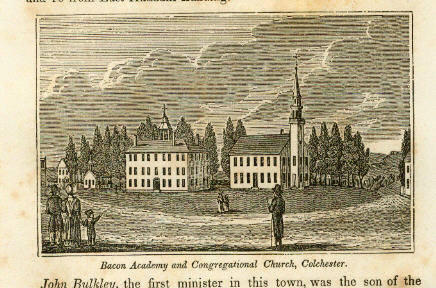
The history of Bacon Academy is but one chapter of the overall history of secondary education in Connecticut. The origin of this institution was the estate of Pierpont Bacon, a prosperous Colchester farmer (and slave-owner) who, dying childless in 1800, left most of his land and other property, amounting to over $35,000, to the inhabitants, of the First Society of Colchester to support and maintain a school of Elementary education being provided for by the town’s local school districts, it was decided by the trustees of Bacon’s request (who were confirmed by the General Assembly) to found a proprietary academy mainly to prepare young men for college, but which also offered local boys the chance to gain an advanced knowledge of English and mathematics to enable them to directly enter commercial careers.
Bacon Academy was not unique; in other eastern Connecticut towns such as Windham, Norwich, Plainfield, and Woodstock similar secondary schools were organized in the last years of the eighteenth and the first years of the nineteenth centuries. Some of. these institutions continue to this day, others have withered away, but each one’s history is different and is the product of many intertwined events and personalities. In briefly sketching the history of Bacon Academy, this larger context should not be forgotten. The new Bacon Academy, constructed at a cost of $7,000, opened its doors to its initial students in 1803.
The school was fortunate to have as its first principal, John Adams, a Yale graduate, who within two months had attracted 206 students to the school including 63 from other towns. Adams put the school on a firm footing but left in 1810 to take up the principal’s office at Phillips Academy in Andover, Massachusetts, where he remained for the next twenty-three years establishing his reputation as an American “Dr. Arnold” (the legendary headmaster of Rugby School in England).
Blackledge River Railroad Bridge
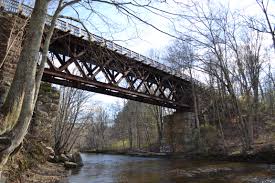
Blackledge River Railroad Bridge is significant as a representative example of the typical medium-length railroad bridge of the early 20th century, and because it was built as part of a major improvement program undertaken by the New York, New Haven and Hartford Railroad between 1907 and 1913, a program that sought to apply up-to-date engineering on a comprehensive basis to the many lines acquired by the Railroad during the prior three decades.
The New York and Boston Air Line Railroad built the first bridge at this location in the early 1870s. A late entrant into the competition for east-west traffic through Connecticut, and further hampered by substantially more difficult topography than its competitors, the Air Line never turned a profit as an independent railroad. By 1881 it had come under the control of the New York, New Haven and Hartford. The New York, New Haven and Hartford acquired more than three dozen other New England railroads in the late 19th and early 20th centuries, and by 1905 it held a virtual monopoly over rail transport in the region. The New York, New Haven and Hartford then set out to rationalize its system and simultaneously to upgrade many of its routes to serve trains that had become both heavier and faster since the acquired lines had been built. Among the major projects initiated between 1905 and 1910 were the electrification of the route along Long Island Sound and the construction of the Cedar Hill Freight yard in New Haven. In 1907 the railroad began designing improvements in the Air Line route, and in 1911 submitted the plans to the state Railroad Commissioners, which approved them. Construction began soon after. The changes included straightening curves, widening embankments and relocating stations.
Henry Champion House
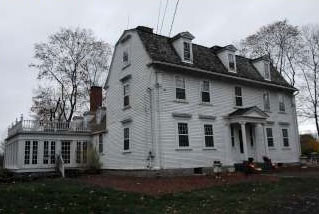
Colonel Henry Champion had this house built for his son, General Henry Champion, in 1790, in area of Colchester known as Westchester. The architect was William Sprat who also designed the Epaphroditus Champion House in East Haddam and the Deming House in Litchfield, both also architecturally important houses in Connecticut. The Colonel (1723-1797) was an active man during the Revolution, was a deputy to the general assembly, and was deacon of the Westchester Church. His son, General Henry, followed his father in many ways. Born on March 16, 1751, he served his country at an early age, being present as an ensign at the Lexington Alarm. He was continuously and quickly promoted, fought at Bunker Hill, and on January 1, 1776, was made adjutant on the staff of Colonel Samuel Wyllys. Champion. was an acting major of the First Battalion, Light Brigade, at the capture of Stony Point, Long Island, And always celebrated Stony Point Day, July 16, at his Colchester home.
In addition to being a military figure of some note, he was an important man in his community. He was a deputy to the general assembly in 1789, 1793-98, 1820-1805, and as assistant from 1806 to 1817. He was a deacon of the Westchester Church from 1813 to 1823. As a financier, he was involved in the amount of $85,000 in the Connecticut Land Company, and helped to obtain a charter for the Phoenix Bank in Hartford. As a result of his work in land settlement, Champion, New York and Champion, Ohio, were named for him. He was a man well thought of in his community. His epitaph is as follows:
The patriotism of General Champion early led him to join the army of Revolution. He was a brave and efficient officer at Bunker Hill. He shared in the perilous retreat of the American troops from, Long Island. He rendered essential services under Kosciusko in constructing the defenses at West Point.
He led the first Battalion of Connecticut Light Infantry at the capture of Stony Point. Subsequently he filled many offices of honor and trust in his native State. By his talents and influence he promoted the welfare of the community where he resided. He died cheered by the hope and sustained by the promises of the Gospel leaving a. memory respected by his friends, cherished by his family, and honorable to the place of his birth.
Museum Exhibit: The Story of the Champion Family
Hayward House

The Hayward House has had a long and interesting history. Built in about 1775, just before the outbreak of the Revolution, by Amos Otis for Dudley Wright, it stands on the site of the home of Wright’s father, Joseph. When it was built it was one of the largest and most impressive homes on the village green. Wright’s property extended to what is present-day Main Street, and included what is now the Town Green, or Center Park. In addition to being a home, it also served as a store, for Captain Wright was a merchant among, other things, a tavern, and the meeting place of the Wooster Lodge of Masons.
In June 1733, Dudley’s daughter Lydia married Dr. John Watrous. The young couple moved into the house and occupied the second floor in place of the masons. In 1793, Wright, then seventy-six years old, deeded the property to his daughter, and continued to live there until he died in 1806. Dr. John Richards Watrous was one of Colchester’s most prominent and respected citizens. He was active in his profession, politics, philanthropic projects, and numerous business ventures. He was one of the organizers and early presidents of the Connecticut Medical Society. Like many residents of the Center, he furnished board and lodging to out-of-town students of Bacon Academy. In 1823 another doctor joined the household: Dr. Frederick Morgan, who married Caroline Watrous. They resided in the house after Dr. Watrous’ death in 1842 until 1848 when they sold it to Nathaniel Hayward, founder and president of the Hayward Rubber Company who built the plant in Colchester in 1847. Nathaniel was an inventor and industrialist. It was he who invented the process of vulcanization of rubber by treating it with sulfur. A patent was issued in 1837 and assigned to Charles Goodyear.
Museum Exhibit: The Hayward Rubber Company
Lyman Viaduct

Lyman Viaduct, completed in 1873, carried a single track of the Boston and New York Airline Railroad between the two ridges on either side of Dickinson Creek. Built by Phoenix Iron Works and designed by Edward W. Serrell, it is a wrought-iron trestle 1,112 feet long and 137 feet high.
The viaduct is presently hidden within a steep embankment that was created by earth-fill in 1912-1913. The viaduct stands in a wooded area about one-quarter mile from the nearest public road; no buildings are visible from the site.
The Air Line, which opened its complete route in 1873, was promoted by business interests from the Middletown area, which had been without direct rail service until that time. The ambitious plan never overcame the serious topographical and economic obstacles that had delayed railroad development in the area. The steep and frequent ridges east of Middletown imposed initial capital costs for bridges, viaducts and grading that were far in excess of those for the first two east-west railroad lines in the state.
The route along Long Island Sound that came under control of the New York, New Haven and Hartford, and the route through Hartford built by the Hartford, Providence and Fishkill. Hoping to establish a reputation for reliability and technical superiority, the Air Line promoters built all their bridges of iron. Lyman Viaduct, the longer but otherwise similar Rapallo Viaduct, and the swing bridge over the Connecticut River at Middletown were the most expensive structures. But while the swing bridge used technology that had already benefited from wide and relatively long-term application, the wrought-iron viaducts represented a type of structure first conceived in 1869, just two years before construction began on Lyman.
They contributed significantly to the line’s high initial cost. Combined with the difficulties in competing with two other east-west railroads that had been open for at least 20 years, the Air Line’s capital cost doomed the railroad to financial ruin.
The Air Line lasted about ten years before succumbing to the inevitable and selling out at bargain rates to the New York, New Haven and Hartford. In 1905, holding a virtual monopoly over rail transport in New England, the New York, New Haven and Hartford set out to rationalize its system and simultaneously to upgrade many of its routes to serve trains that had become both heavier and faster since the acquired lines had been built.
In 1911 the railroad submitted improvement plans for the Air Line to the state Railroad Commissioners, including the scheme to relocate Dickinson Creek in a new culvert and then fill around Lyman Viaduct. The viaduct was clearly inadequate for 20th-century rolling stock, and filling it was a much cheaper alternative than building a new span. For two years, 1912-1913, the railroad ran hopper cars loaded with sand over the viaduct, where they dumped their contents. When the embankment was in place its surface was stabilized with a layer of packed cinders. The crossing carried freight traffic for another 30 years, until the route was abandoned.
River Road Stone Arch Railroad Bridge
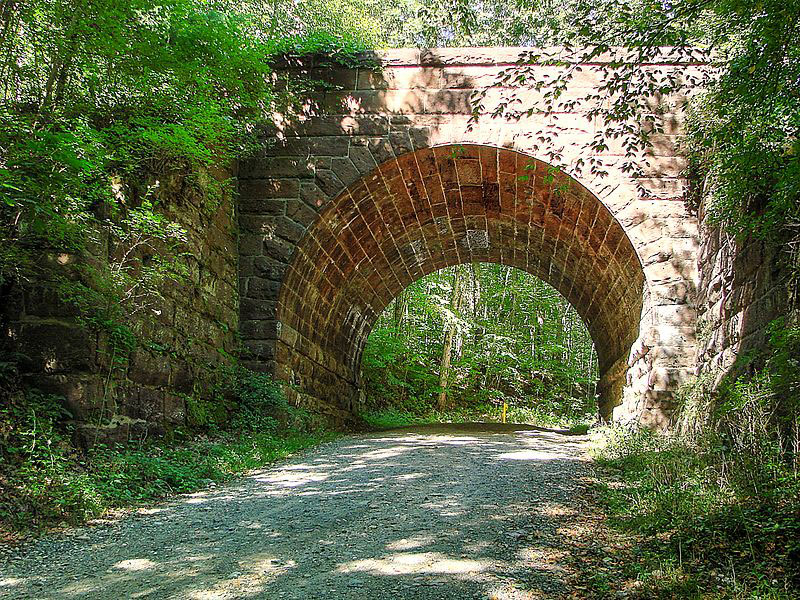
River Road Stone Arch Bridge is significant as a representative example of the short, masonry railroad bridges of the 19th century. It is also significant for its associations with the New York and Boston Air Line Railroad, a notable failure among 19th-century transportation developments in Connecticut; with the New York, New Haven and Hartford Railroad, which dominated rail transport in the state; and with the beginnings of state regulation of public utilities.
In the effort to economize where topography permitted, engineers generally avoided building bridges over roads, preferring instead simple grade crossings. When the Air Line opened in 1873, River Road was one such crossing.
The 1887 stone arch provides an interesting contrast to other structures on the Air Line route, notably the spectacular Lyman viaduct noted above. While the viaducts represent the enormous expense and technical ingenuity involved in beginning a railroad, the simple stone arch illustrates the more prosaic process of managing an existing system. The New York, New Haven and Hartford controlled most of the state’s rail mileage and did not need to attract business by claims of fast service or technical superiority. In building this bridge the railroad’s purpose was limited to compliance with the state’s regulatory authority at the lowest cost.
Far from being spectacular or inventive, the River Road Bridge utilized traditional technology that dated from Classical antiquity. The railroad apparently economized further by performing the most exacting masonry work (cutting the ring stones) for several bridges at a central location, and then shipping the pre-fabricated material to the grade crossings replaced that year; this method accounts for the numbers that appear on the ring stones of the arch. The River Road Bridge represents the beginnings of the system-wide planning and engineering that would culminate in the 1910s, when the New York, New Haven and Hartford developed standardized technology for its various types of structures, then used the standards to revamp all the routes it controlled. By that time, the steel makers produced rolled steel cheaply enough that masonry construction, with its relatively high labor cost, lost out entirely to metal spans. Thus River Road Bridge represents a transitional phase in the state’s railroad development: it falls within the early period of system-wide engineering, but before steel-making improvements and standardized structures caused the railroad to rule out new masonry construction.
Wheeler Block
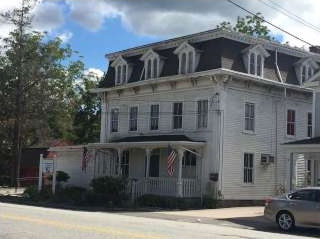
The historic Colchester Town Hall building was built in 1872 by prominent local businessman Joshua B. Wheeler as a commercial block. Wheeler was a member of the local Masonic Lodge and the third floor of the new Wheeler Block was fitted out as meeting space for the fraternal organization. The Masons remained in the upper floor lodge rooms through the 1940s.
In 1910 the building was provided to the town of Colchester school system for use in relieving the overcrowded situation in the grammar schools. The Masons remained in the building with access to their lodge halls provided by a rear entrance.
In the latter 20th century the building was taken over by the town for municipal offices. The Wheeler Block is architecturally significant as a fine local example of the Second Empire style. Within the town of Colchester, only one other Second Empire design is known.
It should be noted that this structure was endangered in the 1990s. A new Town Hall was being built. Some considerations were made to raze it or sell to a commercial enterprise. Citizens banded together to keep the building under the control of Town government.
